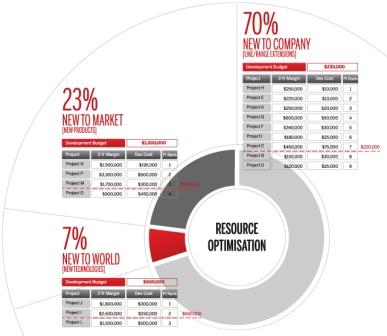In my previous post, I discussed constraint management. In this post, I will focus on the final two suggested approaches: project classification and resource profiling.
Project Classification
The key objective in this approach is to simplify the assessment of projects and their resource requirements using a high level classification system. This has sometimes been referred to as “shirt-sizing” projects and typically uses the classifications such as small, medium, large and extra-large to quickly approximate resource effort per project and therefore the total project capacity.
While this is a valid and logical starting point for many companies seeking to do at least some resource capacity estimation across projects, the classification is often too coarse and leads to the concern that portfolio prioritization decisions based on this data may be inaccurate.
Resource Profiling
The key objective in this approach is to pre-define the resource requirements or resource profile for a project based upon a set of variables. A simple variant may be the process model the project is following, for example:

In addition to the overall development time, the resource demand for any given function or resource pool (R&D, marketing, supply chain, etc.) will vary based upon a set of identifiable parameters, tailored to each business. Typical parameters include:
- Degree of technical risk
- New technology development
- Use of existing (proven) technology
- Degree of market and commercial risk
- New to market
- New to company
- New or existing supply chain
- Capital required or not required
- Testing & stability periods
For any project the different functions required to complete project deliverables are drawn from resource pools. The profile then defines the resource intensity over time for each resource pool. A simple example of a resource profile can be seen in figure one (below).

Figure One: Example of resource profiling for a four stage process.
In many companies the requirement for shelf life or extended product testing will impact the resource and elapsed time profile for new products. In regulated markets such as pharmaceuticals and neutraceuticals, different regulatory approval times in different target markets will impact the resource profile, making launch market a key determinate of the appropriate resource profile.
The key requirement in developing resource profiles is to understand which variables impact the resource demand across projects. Once defined, the selection of project attributes through key variables allows detailed resource definition based upon the minimum set of inputs.
Figure two (below) shows the impact of the Productivity Index in changing the ranking of projects based on the return on investment rather than net sales or margin (contribution). In this example, the productivity rank is determined by the ratio of inputs (development cost) to outputs (3 year margin).

Figure Two: An example of portfolio ranking using the Productivity Index (3 Year Margin / Development Cost)
Portfolio Optimization
The goal to achieve a strategically balanced portfolio of innovation projects requires the definition of strategic buckets or discrete project portfolios. Strategic targets are set which define the proportion of the total development spend which will be allocated to each ‘bucket' or portfolio.
Projects within each bucket compete only against projects in the same bucket. The use of the Productivity Index (enabled by resource estimation) ensures that the ranking of projects within each bucket delivers the optimal return on the total investment in innovation.
In any business the optimization of development productivity or return on investment is the truest measure of the relative financial value of any portfolio of projects. Financial measures should be used in conjunction with strategic measures to optimize the total innovation portfolio.






